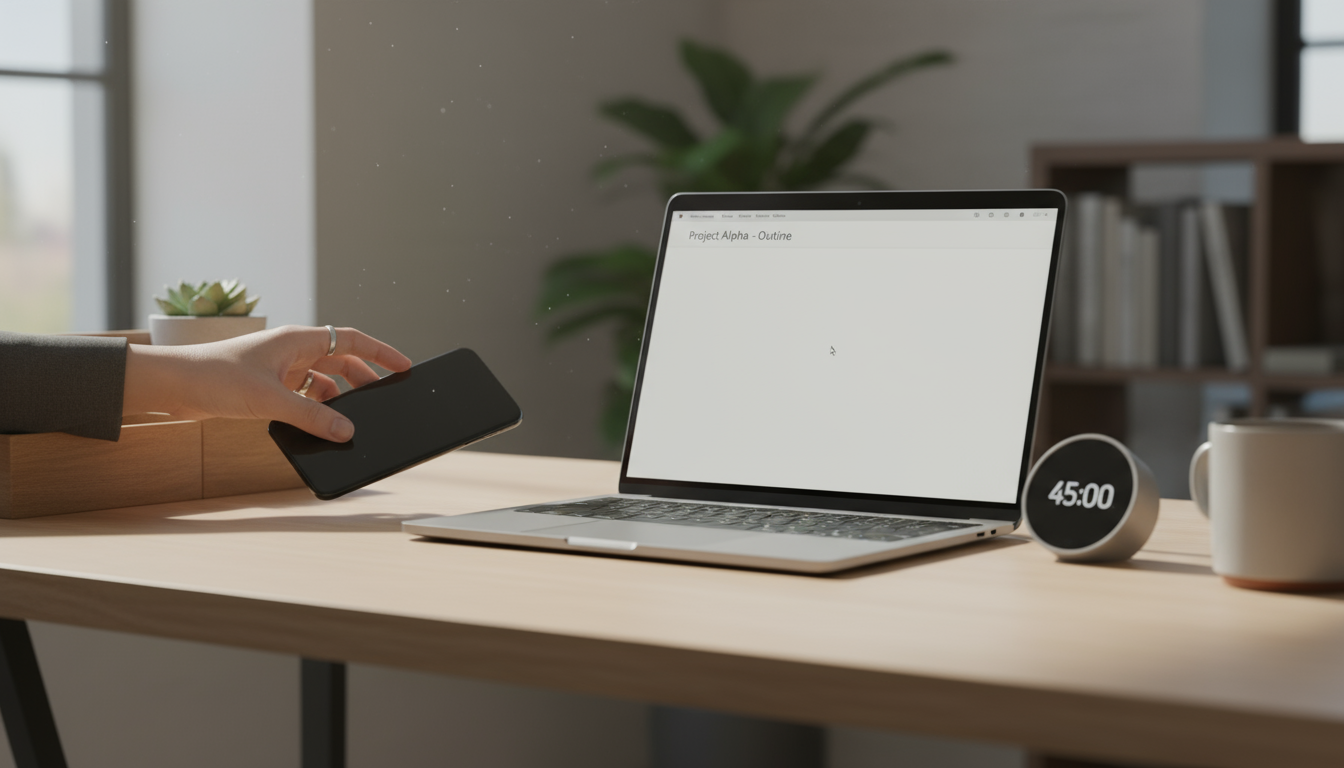
You wake up with good intentions. Today will be different. Today, you will be productive. You will be focused. You grab your phone to turn off the alarm, and the notifications are already there. An urgent email from your boss. A news alert about something unsettling. A reminder from a friend on social media.
Before your feet even touch the floor, your brain is already in a state of reaction. You scan the email, which triggers a cascade of anxious thoughts about your workday. You read the news, and a wave of low-grade dread washes over you. You scroll for just a minute, which turns into ten. You finally get out of bed feeling behind, a little scattered, and already tired. The day hasn’t even truly begun, but you’ve lost the battle for your attention.
This feeling is a form of mental friction. It’s the sense that you are pushing against an invisible force, trying to get your mind to do what you want it to do. You might think the solution is a better, more elaborate morning routine. Maybe you need to wake up earlier, journal for an hour, or drink a special smoothie. But what if the problem isn’t the absence of a routine, but the presence of the wrong one? What if your current morning habits, even the ones that seem productive, are actually sabotaging your ability to concentrate?
Here at TheFocusedMethod.com, we see this all the time. Well-meaning people design morning routines that accidentally flood their brains with information, trigger decision fatigue, and fragment their attention before they even sit down to work. The result is a day spent feeling busy but not productive, overwhelmed but not accomplished.
But there is a better way. It doesn’t require a radical life overhaul. It requires a gentle shift from a checklist of habits to a series of intentional focus rituals. In this article, we will explore why your current morning routine might be undermining your focus. We will give you a simple model for understanding how your attention works. And most importantly, we will provide you with practical, evidence-aware rituals you can use to fix your morning routine, reduce that mental friction, and build a foundation for sustained, deep focus throughout your day.
📚 Table of Contents
- The Hidden Rules of Your Attention
- Your Brain’s Limited Bandwidth: Cognitive Load
- The High Cost of Changing Gears: Context Switching
- Working With Your Energy, Not Against It: Ultradian Rhythms
- From Hectic Habits to Focused Rituals
- The Startup Ritual: Your Mental On-Ramp
- The Deep-Work Entry Ritual: Protecting Your First Hour
- The Break Hygiene Ritual: Recharge Intentionally
- The Shutdown Ritual: Closing the Loops
- A 20-Minute Starter Pack to Fix Your Morning Routine
- The Inner Game: Thought Tools for Lasting Focus
- Reframe Perfectionism: “Good Enough” is Your Ally
- Reduce Friction: Make Focus the Easiest Choice
- Script Your Reset: How to Recover When You Get Derailed
- Focus Rituals in Action: Two Real-World Scenarios
- Frequently Asked Questions About Building a Better Morning Routine
- Is listening to music or white noise good for focus?
- I thought multitasking was a strength. Is it really that bad for my morning routine?
- What if I just have zero motivation in the morning?
- Does my evening routine really affect my morning focus?
- How do I handle urgent requests from my boss or colleagues first thing in the morning?
- Your 7-Day Focus Challenge

The Hidden Rules of Your Attention
To fix your morning routine, you first need to understand what you’re working with: your brain’s attention system. It doesn’t operate on willpower alone. It follows a set of rules and has finite resources. When we violate these rules first thing in the morning, we set ourselves up for a day of distraction. Let’s look at a few key concepts.

Your Brain’s Limited Bandwidth: Cognitive Load
Imagine your brain’s working memory is like the RAM on a computer. It has a limited capacity for holding and processing information at any one time. Cognitive load is the total amount of mental effort being used in your working memory. When you wake up and immediately check emails, social media, and the news, you are force-feeding your brain an enormous amount of new, unstructured information. Each notification, each headline, each request is another program you’ve opened.
Your brain has to process this flood of data. It has to decide what’s important, what’s a threat, and what can be ignored. This process consumes a massive amount of your limited mental energy. By the time you sit down to do your most important work, your cognitive bandwidth is already stretched thin. You feel mentally cluttered and have fewer resources available for complex problem-solving and deep concentration.

The High Cost of Changing Gears: Context Switching
Many people believe they are great multitaskers. The truth is, the human brain cannot focus on two cognitively demanding tasks at once. What we call multitasking is actually rapid context switching. This is the process of disengaging from one task and loading the mental “files” for a new one. Think about shifting from reading a complex work report to answering a text message from a friend about weekend plans. Your brain has to stop thinking about the report, access the social context of your friendship, formulate a reply, and then try to reload all the intricate details of the report.
This switching comes at a significant cost. Research from institutions like the American Psychological Association shows that context switching can eat up as much as 40 percent of your productive time. Every switch leaves behind what’s called “attention residue,” where thoughts from the previous task linger and interfere with your focus on the new one. A morning spent jumping between your inbox, the news, and your to-do list is a masterclass in context switching. You are training your brain to be distracted before the workday even starts.

Working With Your Energy, Not Against It: Ultradian Rhythms
Our energy and focus are not constant throughout the day. They operate in cycles. Most of us are familiar with the circadian rhythm, our 24-hour sleep-wake cycle. But we also have smaller cycles that play out during the day called ultradian rhythms. These are natural cycles of high-frequency brain activity followed by periods of low-frequency activity, typically lasting 90 to 120 minutes.
During the high-energy phase, we are primed for deep focus and high performance. During the low-energy phase, our brains need to rest, consolidate information, and recharge. When we ignore these natural rhythms—by trying to power through for hours on end without a break—we experience diminished focus, increased errors, and eventual burnout. A bad morning routine that front-loads distraction and cognitive overload wastes that precious first peak-energy cycle of the day. Instead of using it for your most important work, you spend it managing chaos. A good routine, however, honors these rhythms, protecting that first cycle for deep, meaningful work.

From Hectic Habits to Focused Rituals
The solution is not to add more to your morning, but to add more intention. The difference between a habit and a ritual is this: a habit can be performed mindlessly, but a ritual is an action infused with purpose. You don’t just “check email.” You perform a “startup ritual” to mindfully begin your day. This shift in framing is powerful. It turns a series of automatic, often counterproductive behaviors into a conscious practice designed to protect and direct your focus.
Let’s build your new focus system with four key rituals: the startup, the deep-work entry, break hygiene, and the shutdown.

The Startup Ritual: Your Mental On-Ramp
The goal of the startup ritual is to create a clear, deliberate transition from your personal life into your work life. It’s an on-ramp for your mind. Instead of crashing into your workday by opening your inbox, you ease into it with intention. This ritual should be short, simple, and consistent.
Your startup ritual signals to your brain that it’s time to focus. It could involve tidying your desk for two minutes. It could be pouring a glass of water and setting it next to your computer. A particularly powerful startup ritual is to take five minutes to define your day’s purpose. Don’t write a massive to-do list. Instead, identify the one or two most important tasks that will make the day a success. Write them on a sticky note and place it where you can see it. This simple act moves you from a reactive to a proactive state. You are telling your brain what matters *before* the world tells you what it thinks matters.

The Deep-Work Entry Ritual: Protecting Your First Hour
Your first 90-minute energy cycle is your most valuable asset of the day. You must protect it fiercely. The deep-work entry ritual is designed to do just that. It’s a series of actions that launches you directly into your most important task without distraction. This is where you practice monotasking, which is the art of focusing on a single task for a sustained period. It is the opposite of context switching and the gateway to high-quality work.
Your entry ritual might look like this: you sit at your desk, turn your phone to silent and place it out of sight, and close all unnecessary browser tabs and applications. You open only the one document or program needed for your most important task. You set a timer for 60 or 90 minutes. Then, you begin. You do not check email. You do not check messages. You give your full, undivided attention to that single priority. This creates a powerful state of immersion and can lead to a state of flow, where you are so absorbed in an activity that time seems to disappear. This is where your best work happens.

The Break Hygiene Ritual: Recharge Intentionally
Breaks are not a reward for good work; they are a prerequisite for it. Honoring your ultradian rhythms means taking intentional breaks to recharge your cognitive resources. However, not all breaks are created equal. A “bad” break involves swapping one high-stimulus screen for another, like scrolling through social media. This doesn’t allow your brain to rest; it just provides a different flavor of cognitive load.
Good break hygiene means disconnecting intentionally. After a 90-minute focus block, stand up. Stretch. Walk around the room. Get some water. Look out a window and let your eyes focus on something in the distance. This is especially important for reducing eye strain. A five-to-ten-minute break involving light physical movement and no screens is far more restorative than ten minutes of scrolling. It allows your brain to clear the attention residue from your previous task and prepare for the next focus session.

The Shutdown Ritual: Closing the Loops
Just as a good morning routine starts with a deliberate startup, a focused day ends with a deliberate shutdown. The shutdown ritual is a clear signal to your brain that the workday is over. This is crucial for preventing work from bleeding into your personal time and for reducing the “always-on” anxiety that plagues so many of us.
Your shutdown ritual can be simple. Spend the last five minutes of your day reviewing what you accomplished. Quickly plan your top one or two priorities for the next day. This closes open mental loops and reduces the chance you’ll lie awake at night thinking about work. Then, tidy your workspace. Close all the tabs on your computer. Finally, say a simple phrase to yourself, like “The workday is complete.” This act of closure allows you to mentally check out and be fully present in your evening, ensuring you are better rested and more prepared for the next day.

A 20-Minute Starter Pack to Fix Your Morning Routine
Feeling overwhelmed? Don’t try to implement everything at once. Start here. Commit to this simple 20-minute sequence for one week.
1. First 5 Minutes: Hydrate and Move. Before you touch your phone, drink a glass of water. Do a few simple stretches. Let your body wake up before your mind gets flooded.
2. Next 5 Minutes: Define Your Priority. Sit down with a pen and paper. Look at your plan from the previous day’s shutdown ritual. Identify the single most important task for the day. Write it down and nothing else.
3. Final 10 Minutes: Take the First Step. Open only what you need for that one task. Set a timer for just 10 minutes and start. The goal isn’t to finish it; the goal is simply to begin without distraction. This small win builds momentum for the rest of the day.

The Inner Game: Thought Tools for Lasting Focus
Building effective focus rituals is about more than just changing your actions; it’s about shifting your mindset. The external rituals are powerful, but they are supported by an internal foundation of thought tools. These mental models help you overcome the psychological barriers that so often lead to distraction and procrastination.

Reframe Perfectionism: “Good Enough” is Your Ally
Perfectionism is one of the greatest enemies of focus. It whispers that you cannot start a task until you know exactly how to do it perfectly. It tells you that a messy first draft is a sign of failure. This creates immense pressure and friction, making it far more appealing to check your email or do some “easy” shallow work instead of tackling the big, important project.
The antidote is to reframe your goal. Instead of aiming for a perfect outcome, aim for a “good enough” start. Give yourself permission to create a messy, imperfect first version. Tell yourself, “My only goal for this first focus session is to get 100 words on the page,” or “I will just outline the basic structure.” By lowering the stakes, you reduce the fear and make it easier to begin. Momentum is a powerful force. Once you start, it’s much easier to continue and refine your work later.

Reduce Friction: Make Focus the Easiest Choice
Our brains are wired to follow the path of least resistance. If distraction is easy and focus is hard, your brain will choose distraction every time. The key is to re-engineer your environment to make focus the path of least resistance. This is the practice of reducing friction.
If you find yourself mindlessly checking social media, use a website blocker during your designated focus hours. If your phone is the first thing you reach for, move your charger to another room so you have to physically get up to get it in the morning. Prepare for your deep-work entry ritual the night before. Lay out the materials you need. Open the correct file on your computer and then put it to sleep. When you arrive at your desk in the morning, the path to starting your most important work is clear and easy. You’ve removed the small hurdles that can derail your intention.

Script Your Reset: How to Recover When You Get Derailed
No matter how perfect your rituals are, you will get distracted. A family member will interrupt you. A fire-drill email will land in your inbox. You’ll find yourself on a Wikipedia rabbit trail. This is not a failure; it is a normal part of being human. The most important skill is not avoiding all distractions but learning to recover from them quickly and without judgment.
To do this, create a simple reset script. It’s a non-judgmental phrase you say to yourself to gently guide your attention back to your task. It could be something as simple as, “Okay, my mind wandered. I am now returning my focus to the report.” Or, “That was a distraction. Back to the task at hand.” The key is the neutral, compassionate tone. Avoid self-criticism like, “Ugh, I can’t believe I wasted 10 minutes!” That kind of negative self-talk only adds another layer of cognitive load and makes it harder to refocus. A simple, practiced script short-circuits that shame spiral and makes your recovery almost instantaneous.

Focus Rituals in Action: Two Real-World Scenarios
Theory is helpful, but seeing these principles in practice makes them real. Let’s explore how these focus rituals can transform two common, challenging situations.

Scenario 1: The Urgent Project Deadline
The Common Approach (Reactive): Sarah wakes up to a 6 AM email from her boss about a project deadline that’s been moved up. Her heart races. She grabs her phone and starts firing off replies from bed, trying to coordinate with her team. She skips breakfast, gets to her desk, and opens her email, her messaging app, and the project file all at once. She spends the first 90 minutes of her day bouncing between panicked messages and trying to figure out where to even start on the project. She feels incredibly busy, but by 10 AM, she hasn’t made any meaningful progress on the actual work.
The Focused Ritual Approach (Proactive): David wakes up to the same email. He sees the subject line but resists the urge to open it. He follows his 20-minute starter pack. He hydrates, stretches, and then sits at his desk with a notebook. He performs a startup ritual: he takes three deep breaths and writes down the new reality: “The deadline is today.” He then asks, “What is the single most critical part of this project I must complete first?” He identifies it. He then begins his deep-work entry ritual. He puts his phone in another room, closes his email client, and opens only the document he needs to work on. He sets a timer for 90 minutes and immerses himself in that one critical task. At the end of the 90 minutes, he has completed a huge chunk of the most important work. He then takes a five-minute break and *only then* opens his email to coordinate with the team, now from a position of accomplishment and control, not panic.

Scenario 2: The Noisy Home Office
The Common Approach (Friction-filled): Maria works from home with her partner and children. She tries to start work, but her kids are asking for breakfast, and her partner is on a loud phone call in the next room. She feels frustrated and resentful. She tries to work but gets interrupted every ten minutes. Her attention is fragmented, she gets irritable, and her productivity plummets. She feels like she can’t get anything done until everyone leaves the house, which means her most important work gets pushed to later in the day when her energy is lower.
The Focused Ritual Approach (Boundary-Setting): Maria knows her environment is challenging. She uses rituals to create a “bubble of focus.” Her startup ritual now includes a five-minute conversation with her partner to align their schedules. She communicates, “I am starting a 90-minute focus block now. I need this time to be uninterrupted unless it’s a true emergency.” She performs her deep-work entry ritual by putting on noise-canceling headphones and playing an instrumental focus playlist. This serves as a “do not disturb” sign for her family. She also scripts her reset. When her child inevitably interrupts her to ask a question, instead of getting frustrated, she takes a breath, answers the question briefly, and then uses her script: “Okay, back to the presentation.” The rituals don’t magically make her home silent, but they give her a structure to manage the chaos, set boundaries, and quickly recover her focus when interruptions happen.

Frequently Asked Questions About Building a Better Morning Routine
As you begin to implement these changes, questions will naturally arise. Here are answers to some of the most common ones we hear from clients at TheFocusedMethod.com.
Is listening to music or white noise good for focus?
The answer is highly personal. For some, ambient or white noise can be incredibly effective at masking distracting background sounds. For others, instrumental music, especially electronic or classical, can help create a “sound cocoon” that signals to the brain it’s time to focus. However, music with lyrics can be a major source of distraction, as the language-processing parts of your brain are activated, adding to your cognitive load. The best approach is to experiment. Try different options—silence, white noise, instrumental music—and honestly assess whether it helps or hinders your ability to concentrate.
I thought multitasking was a strength. Is it really that bad for my morning routine?
The idea of multitasking as a workplace skill is a persistent myth. As we discussed, our brains don’t truly multitask on complex tasks; they just switch between them very quickly. This context switching is neurologically costly. It drains your mental energy, increases the time it takes to complete tasks, and can lead to more errors. Evidence from cognitive psychology is clear on this. For more on the cognitive costs, you can explore resources from organizations like the American Psychological Association. A morning routine that embraces monotasking—focusing on one thing at a time—will always be more powerful than one built on the illusion of multitasking.
What if I just have zero motivation in the morning?
This is a very common feeling. The beauty of a ritual-based approach is that it does not depend on motivation. Motivation is a fickle emotion; it comes and goes. A ritual is an action you take regardless of how you feel. The 20-minute starter pack is designed specifically for low-motivation days. The goal isn’t to feel excited about work; it’s to simply follow a few small, pre-decided steps. Don’t wait for motivation to strike. Let your ritual lead the way. Action often precedes motivation, not the other way around. Once you start and get a small win, you may find that motivation follows.
Does my evening routine really affect my morning focus?
Absolutely. Your morning doesn’t start when your alarm goes off; it starts the night before. A proper shutdown ritual, as we discussed, is the first step. The second is prioritizing sleep. Sleep is not a passive state; it’s when your brain works hard to consolidate memories, clear out metabolic waste, and restore energy. A lack of quality sleep severely impairs your prefrontal cortex, the part of your brain responsible for executive functions like focus, planning, and impulse control. For in-depth information on the importance of sleep hygiene, we recommend visiting the National Institutes of Health homepage. A good night’s sleep is one of the most effective productivity tools available.
How do I handle urgent requests from my boss or colleagues first thing in the morning?
This is a major challenge in many work cultures. The key is managing expectations. If you protect your first 60-90 minutes for deep work, you can let your colleagues know that you will be responsive after that time. You can use status updates in a shared messaging app to signal that you are in a “focus block” and will check messages at a specific time, for example, 10:30 AM. Of course, some interruptions are unavoidable. The goal is not to become unreachable but to shift the dynamic from being constantly reactive to being intentionally proactive for at least one critical work cycle each day.

Your 7-Day Focus Challenge
Understanding these concepts is the first step. Taking action is what creates change. We invite you to move from theory to practice with a simple, seven-day challenge. Don’t try to perfect your entire life. Just commit to a few small, intentional shifts and observe what happens. The goal is progress, not perfection.
For the next seven days, we encourage you to try the following actions. Treat it as an experiment. Be curious. Notice how you feel. Notice the quality of your work.
1. No Phone for the First 30. For the first 30 minutes after you wake up, do not touch your phone for anything other than turning off your alarm. No email, no news, no social media. Give your brain the gift of a gentle start. This one change alone can be transformative.
2. Implement the 20-Minute Starter Pack. Each workday, practice the simple 20-minute routine: 5 minutes of hydrating and movement, 5 minutes of defining your single priority, and 10 minutes of starting that task. That’s it. This small commitment sets a powerful trajectory for your day.
3. Practice a 5-Minute Shutdown. At the end of each workday, take just five minutes to close your mental loops. Tidy your space, identify your main task for tomorrow, and consciously declare your workday finished. This creates a boundary that protects your evening and prepares your morning.
4. Use Your Reset Script. When you get distracted—and you will—don’t get frustrated. Simply notice it and use your gentle reset script. “Okay, that was a distraction. Returning my attention now.” Practice this compassionate recovery at least once a day.
Your morning sets the tone for your entire day. A morning lost to distraction and reaction creates a day of overwhelm. But a morning won with intention creates a day of focus, clarity, and accomplishment. You have the power to fix your morning routine, not by adding more complexity, but by embracing simple, powerful rituals. Start today. Start small. Your future focused self will thank you.
Disclaimer: The information provided in this article is for informational purposes only and is not intended as a substitute for professional medical or psychological advice, diagnosis, or treatment. Always seek the advice of your physician or other qualified health provider with any questions you may have regarding a medical condition or mental health.






